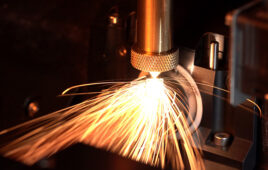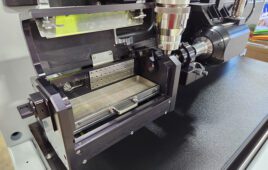Ultrafast laser processing is unlocking the next generation of medical device manufacturing.
By Bryan Germann and Travis Schneider, Aerotech

An ultrafast laser’s extremely short pulse duration can deliver higher peak power to a device part than continuous wave or pulsed lasers. Pictured here is the Aerotech AGV5D Five-Axis Laser Micromachining Precession Scanner. [Photo courtesy of Aerotech]
Many device OEMs now look to ultrafast laser technology as the next horizon for their manufacturing needs. Why is this?
To answer that question, it is important to understand what defines an ultrafast laser. In general terms, there are two primary operating modes for lasers: continuous wave (CW) and pulsed.
As their name implies, continuous wave lasers operate with a constant output. Pulsed lasers intermittently output laser energy at a constant interval known as the pulse width or pulse duration (see Figure 1 for a visual reference of these operating modes). Ultrafast lasers represent a segment of pulsed laser technology where the laser pulse duration is mere femtoseconds (10-15), an extremely short time period.

Figure 1: These charts show the difference in operation between continuous wave and pulsed lasers. [Image courtesy of Aerotech]
Athermal laser processing
CW and pulsed lasers can cut or machine materials, but ultrafast lasers do this in a powerful and unique way. Ultrafast lasers’ high peak power capability allows the material to be vaporized from a solid to a plasma with little or no heat transfer from the pulse to the surrounding material. This is commonly referred to as athermal laser processing, or cold ablation.
Athermal laser processing is highly advantageous for medical device manufacturing because it enables the processing of thin or thermally sensitive materials such as polymers and specialty alloys — including nitinol — without introducing a heat affected zone (HAZ) around the processed area. HAZ is a common consequence of laser processing that can lead to part distortion or even premature mechanical failure.
This ability to process parts without altering the material properties that are critical to product performance is a key advantage of ultrafast lasers when compared to CW or longer pulse duration lasers.
Minimized part post-processing

Figure 2: This magnified view of a laser cut cobalt-chromium part shows small imperfections that required post-processing. Through proper ultrafast laser process refinement, it is possible to produce parts that require little-to-no post-processing. [Photo courtesy of Aerotech]
These steps require additional equipment and processes — plus the accompanying control plans and time — that affect part throughput and cost. These additional steps may be avoided when material removal is done through a refined ultrafast process, improving part processing time and lowering cost.
Ultrafast lasers can also eliminate steps related to part coating. Because they can manipulate a material’s microstructure to generate hydrophobic or hydrophilic surface finishes, ultrafast laser processes can texture a surface directly. In this case, no additional steps would be needed to apply a coating.
By simply changing process parameters and adding some cycle time to the laser processing step, an ultrafast laser can reduce or eliminate post-processing steps needed to deliver a finished part. In these applications, special attention is paid to the controls and laser delivery system because it is critical to maintain the optimum laser spot over non-planar surfaces.
Unique laser welding advantages
An ultrafast laser also enables unique joining methods that have implications for novel medical device designs. By using different laser process controls and techniques (e.g. adjustable burst firing modes) it is possible to join dissimilar materials such as ceramics and metals or extremely fine metal foils.
However, these processes have a much smaller process control window, and the motion of the laser along the surface plays a significant role in achieving high-quality weld joints. Improper control of the laser’s position when triggering or the laser’s pulse control along that path can create inconsistencies in weld strength and reliability.
Getting started
From eliminating secondary processes to enabling new cutting or joining techniques, ultrafast laser technology has the potential to make significant improvements in medical device manufacturing. Despite the higher capital investment tied to ultrafast technology, the potential for cost savings is notable.
Because these advantages require significant refinement of the laser process to optimize the right parameters, it’s essential to have a suite of tools at your disposal that allow for proper experiment design.

Bryan Germann [Photo courtesy of Aerotech]
When evaluating control solutions, it is key to work with suppliers who understand this interdependency and will help to align these technologies to best achieve your manufacturing objectives.
Learn more about lasers for device manufacturing in our Medical Design & Outsourcing webinar, Precision Automation Technologies that Minimize Laser Cut Hypotube Manufacturing Risk.
Aerotech Product Manager Bryan Germann focuses on light manipulation products, including Aerotech’s AGV laser scan heads and associated Automation1 drives and software control features. He has hands-on experience designing and managing the production of high-precision motion control and automation machinery and products. Germann earned his bachelor’s and master’s degrees in mechanical engineering from the University of South Carolina. He holds 17 U.S. and international patents.

Travis Schneider [Photo courtesy of Aerotech]
How to submit a contribution to MDO
The opinions expressed in this blog post are the author’s only and do not necessarily reflect those of Medical Design & Outsourcing or its employees.




